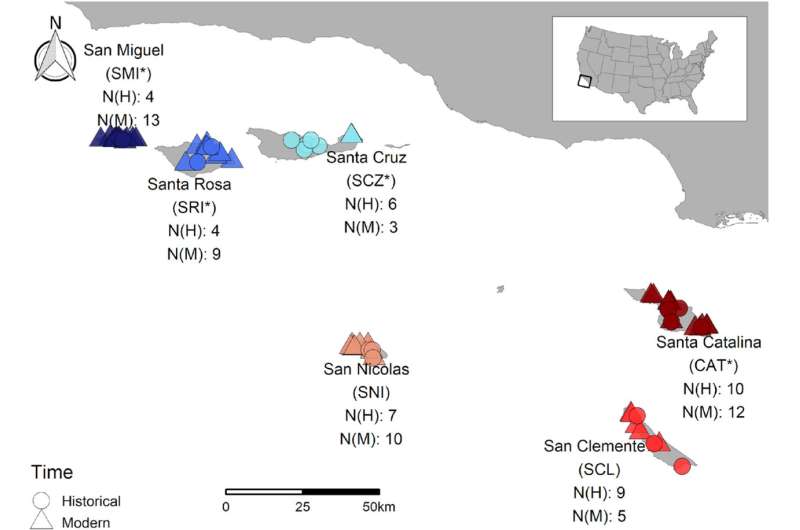Saved from extinction, Southern California’s Channel Island Foxes now face new threat to survival

Tiny foxes—each no bigger than a five-pound housecat—inhabiting the Channel Islands off the coast of Southern California were saved from extinction in 2016. However, new research reveals that the foxes now face a different threat to their survival.
Suzanne Edmands, professor of biological sciences at USC Dornsife College of Letters, Arts and Sciences, and Nicole Adams, who earned her Ph.D. from USC Dornsife in 2019, found that the foxes’ genetic diversity has decreased over time, possibly jeopardizing their survival and the biodiversity of the islands.
“The findings of this study highlight the alarming fact that the foxes currently inhabiting six of the Channel Islands possess extremely low genetic diversity, rendering them potentially more susceptible to dangers such as disease outbreaks and climate-induced environmental shifts,” Edmands said.
As the largest native land animals on the islands located 22 miles off the coast of Southern California, these bushy-tailed, big-eared creatures play a vital role in regulating plant and animal communities by consuming various food sources, including fruit, insects, snails, lizards, birds, and rodents. In fact, many plant species rely on them to distribute seeds through their scat.
“The importance of these animals to the overall biodiversity of the island can’t be over-emphasized. Without them, we could lose other species as well,” Edmands said.
A previous study done in 2018 lacked sufficient sampling to detect changes in genetic variation. This new study used a broader sampling method, comparing historic museum specimens and modern blood samples.
Interestingly, the results indicated extremely low genetic variation even before the population declines. It also revealed that the genetic variation had dropped even further since population numbers fell. The islands that experienced the most severe losses, San Miguel and Santa Rosa, also showed the greatest reduction in genetic diversity. Santa Cruz and Santa Catalina, two islands where populations fell moderately, displayed mixed changes in genetic diversity metrics.
Placing these island foxes on the endangered species list from 2004-16 played a crucial role in population recovery. By 2017—a year after they were removed as an endangered species —the population on Catalina was found to have increased over that 13-year period from approximately 100 to more than 2,000, while Santa Rosa Island’s fox population rose from a low of 15 to more than 1200 over the same time span. However, their depleted genetic diversity continues to hinder the foxes’ ability to adapt to future challenges, such as global warming and introduced diseases.
While genetic variation is crucial for disease resistance and adaptation to climate change, the scientists did find one silver lining in their research. They found reasonably good diversity within the foxes’ gut microbiome, a key player in bolstering immunity and overall well-being.
“This discovery suggests that the foxes may have developed an alternative mechanism to cope with changing environmental conditions,” Edmands said.
The study also reveals an increased divergence between the six islands over time. This finding complicates the possible conservation strategy of moving foxes between islands to increase genetic variation. Such a move could inadvertently disrupt local adaptation by producing offspring that are less fit or not as well adapted to their specific environments. It should be noted that each island population is recognized as a separate endemic or unique subspecies.
Given their limited ability to respond to new challenges, long-term monitoring of the fox population is crucial. To that end, researchers have already started non-invasive monitoring by sequencing bacterial communities in the foxes’ scat.
“The recovery of fox population numbers is an incredible conservation success, but their fragile genetic condition means that continued vigilance is critical to ensure their survival,” Edmands said.
The work is published in the journal Molecular Ecology.
More information:
Nicole E. Adams et al, Genomic recovery lags behind demographic recovery in bottlenecked populations of the Channel Island fox, Urocyon littoralis, Molecular Ecology (2023). DOI: 10.1111/mec.17025
Citation:
Saved from extinction, Southern California’s Channel Island Foxes now face new threat to survival (2023, May 31)
retrieved 31 May 2023
from https://phys.org/news/2023-05-extinction-southern-california-channel-island.html
This document is subject to copyright. Apart from any fair dealing for the purpose of private study or research, no
part may be reproduced without the written permission. The content is provided for information purposes only.
For all the latest Science News Click Here
For the latest news and updates, follow us on Google News.

